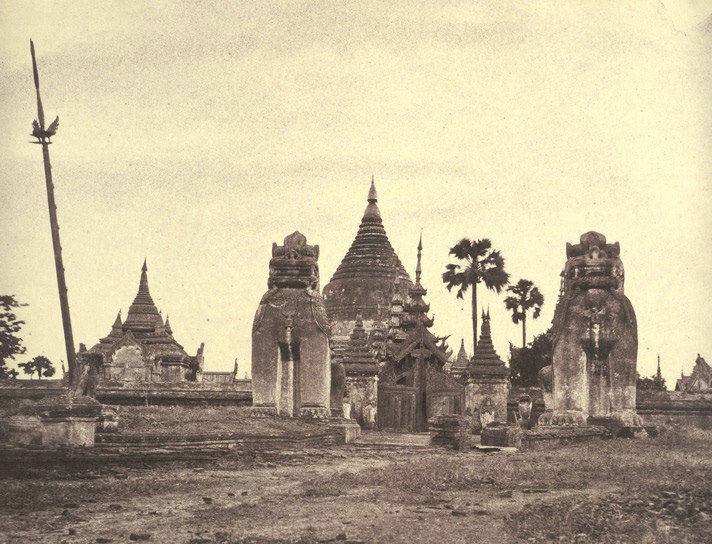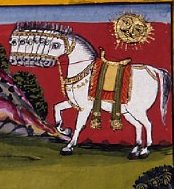|
Thagyamin
Thagyamin ( my, သိကြားမင်း, ; from Sanskrit ''Śakra'') is the highest-ranking nat (deity) in traditional Burmese Buddhist belief. Considered as the king of Heaven, he is the Burmese adaptation of the Hindu deity Indra. Etymology Thagyamin () is derived from the combination of the Sanskrit word "Shakra" (शक्र; a synonym of Indra) and the Burmese word "Min" (; a common title meaning Lord/King). He is also known by his nickname ''U Magha'' () derived from his preexistential name. Description Thagyamin is often portrayed as holding a conch shell in one hand, and a yak-tail fly-whisk in the other, and seated or standing atop a three-headed white elephant (Airavata). He is described as the ruler of the celestial kingdom Trāyastriṃśa (). He was designated as the supreme deity of the official pantheon of 37 ''ahtet nat'' (အထက်နတ်, upper deities) by King Anawrahta in the 11th century, in an effort to streamline animist and Hindu p ... [...More Info...] [...Related Items...] OR: [Wikipedia] [Google] [Baidu] |
Nat (spirit)
The nats (; MLCTS: ''nat''; ) are god-like spirits venerated in Myanmar and neighbouring countries in conjunction with Buddhism. They are divided between the 37 ''Great Nats'' who were designated that status by King Anawrahta when he formalized the official list of nats. Most of the 37 ''Great Nats'' were human beings who met violent deaths. There are two types of ''nats'' in Burmese Belief: ''nat sein'' () which are humans that were deified after their deaths and all the other nats which are spirits of nature (spirits of water, trees etc.). Much like sainthood, ''nats'' can be designated for a variety of reasons, including those only known in certain regions in Burma. ''Nat'' worship is less common in urban areas than in rural areas and is practised among ethnic minorities of Myanmar as well as in mainstream Bamar society. However, it is among the Theravada Buddhist Bamar that the most highly developed form of ceremony and ritual is seen. Every Burmese village has a ''nat k ... [...More Info...] [...Related Items...] OR: [Wikipedia] [Google] [Baidu] |
Shwezigon Pagoda
The Shwezigon Pagoda or Shwezigon Paya ( my-Mymr, ရွှေစည်းခုံဘုရား ) is a Buddhist stupa located in Nyaung-U, Myanmar. A prototype of Burmese stupas, it consists of a circular gold leaf-gilded stupa surrounded by smaller temples and shrines. Construction of the Shwezigon Pagoda began during the reign of King Anawrahta (r. 1044–1077), the founder of the Pagan Empire, in 1059–1060 and was completed in 1102, during the reign of his son King Kyansittha. Over the centuries the pagoda had been damaged by many earthquakes and other natural calamities, and has been refurbished several times. In recent renovations it has been covered by more than 30,000 copper plates. However, the lowest level terraces have remained as they were. This pagoda, a sacred Buddhist religious place, is believed to enshrine a bone and tooth of Gautama Buddha. The pagoda is in the form of a cone formed by five square terraces with a central solid core. There are footprints b ... [...More Info...] [...Related Items...] OR: [Wikipedia] [Google] [Baidu] |
Nat (deity)
The nats (; MLCTS: ''nat''; ) are god-like spirits venerated in Myanmar and neighbouring countries in conjunction with Buddhism. They are divided between the 37 ''Great Nats'' who were designated that status by King Anawrahta when he formalized the official list of nats. Most of the 37 ''Great Nats'' were human beings who met violent deaths. There are two types of ''nats'' in Burmese Belief: ''nat sein'' () which are humans that were deified after their deaths and all the other nats which are spirits of nature (spirits of water, trees etc.). Much like sainthood, ''nats'' can be designated for a variety of reasons, including those only known in certain regions in Burma. ''Nat'' worship is less common in urban areas than in rural areas and is practised among ethnic minorities of Myanmar as well as in mainstream Bamar society. However, it is among the Theravada Buddhist Bamar that the most highly developed form of ceremony and ritual is seen. Every Burmese village has a ''nat kun ... [...More Info...] [...Related Items...] OR: [Wikipedia] [Google] [Baidu] |
Śakra (Buddhism)
Śakra (Sanskrit: शक्र Śakra; Pali: सक्क Sakka) is the ruler of the Trāyastriṃśa Heaven according to Buddhist cosmology. He is also referred to by the title "Śakra, Lord of the Devas" (Sanskrit: '; Pali: '). The name Śakra ("powerful") as an epithet of Indra is found in several verses of the Rigveda. In East Asian cultural traditions, Śakra is known as ''Dìshìtiān'' (帝釋天) or ''Shìtí Huányīn'' (釋提桓因) in Chinese, as ''Taishakuten'' (帝釈天) in Japanese, as ''Jeseokcheon'' (제석천) in Korean, and as ''Đế Thích Thiên'' (帝釋天) or ''Thích Đề Hoàn Nhân'' (釋提桓因) in Vietnamese. In Chinese Buddhism, Śakra is sometimes identified with the Taoist Jade Emperor (Yùhuáng Dàdì 玉皇大帝, often simplified to Yùhuáng 玉皇); both share a birthday on the ninth day of the first lunar month of the Chinese calendar (usually in February). The Trāyastriṃśa heaven in which Śakra rules is located on the top o ... [...More Info...] [...Related Items...] OR: [Wikipedia] [Google] [Baidu] |
Burmese Folk Religion
Burmese folk religion refers to the animistic and polytheistic religious worship of '' nats'' (deities of local and Hindu origin) and ancestors in Myanmar (Burma). Although the beliefs of nats differ across different regions and villages in Burma, there are a handful of beliefs that are universal in Burmese folk religion. A nat is a god like spirit. There are two main types of nats: nat sein (နတ်စိမ်း) which are humans who were deified after their deaths and all the other nats which are spirits of nature (spirits of water, trees etc.). Nats are usually venerated in shrines called nat kun (နတ်ကွန်း) or nat sin (နတ်စင်). They can be placed anywhere to honor nature spirits ( spirit houses) or they may be specialized shrines for particular nats. A village will traditionally also have a spirit which is their local patron; this is called a Bo Bo Gyi. History and origins The precise origins of Burmese folk faith and nat worship are not de ... [...More Info...] [...Related Items...] OR: [Wikipedia] [Google] [Baidu] |
Indra
Indra (; Sanskrit: इन्द्र) is the king of the devas (god-like deities) and Svarga (heaven) in Hindu mythology. He is associated with the sky, lightning, weather, thunder, storms, rains, river flows, and war. volumes/ref> Indra's myths and powers are similar to other Indo-European deities such as Jupiter, Perun, Perkūnas, Zalmoxis, Taranis, Zeus, and Thor, part of the greater Proto-Indo-European mythology. Indra is the most referred deity in the ''Rigveda''. He is celebrated for his powers, and as the one who killed the great evil (a malevolent type of asura) named Vritra, who obstructed human prosperity and happiness. Indra destroys Vritra and his "deceiving forces", and thereby brings rains and sunshine as the saviour of mankind. He is also an important deity worshipped by the Kalash people, indicating his prominence in ancient Hinduism. Indra's significance diminishes in the post-Vedic Indian literature, but he still plays an important role in ... [...More Info...] [...Related Items...] OR: [Wikipedia] [Google] [Baidu] |
Buddhism In Myanmar
Buddhism ( my, ဗုဒ္ဓဘာသာ), specifically Theravāda Buddhism ( my, ထေရဝါဒဗုဒ္ဓဘာသာ), is the State religion of Myanmar since 1961, and practiced by nearly 90% of the population. It is the most religious Buddhist country in terms of the proportion of monks in the population and proportion of income spent on religion. Adherents are most likely found among the dominant Bamar people, Shan, Rakhine, Mon, Karen, and Chinese who are well integrated into Burmese society. Monks, collectively known as the sangha (community), are venerated members of Burmese society. Among many ethnic groups in Myanmar, including the Bamar and Shan, Theravada Buddhism is practiced in conjunction with the worship of nats, which are spirits who can intercede in worldly affairs. Regarding the practice of Buddhism, two popular practices stand out: merit-making and vipassanā meditation. There is also the less popular weizza path. Merit-making is the most ... [...More Info...] [...Related Items...] OR: [Wikipedia] [Google] [Baidu] |
Uchchaihshravas
In Hinduism, Uchchaihshravas ( sa, उच्चैःश्रवस्, Uccaiḥśravas or sa, उच्चैःश्रवा, Uccaiḥśravā, label=none, "long-ears" or "neighing aloud") is a seven-headed flying horse, created during the churning of the milk ocean. It is considered the best of horses, the prototype and the king of the horses. Uchchaihshravas is often described as a '' vahana'' ("vehicle") of Indra (the king of the gods), but is also recorded to be the horse of Bali, the king of the asuras (demons). Uchchaihshravas is said to be snow white in colour. Literature Mahabharata The ''Mahabharata'' mentions that Uchchaihshravas rose from the Samudra Manthana ("churning of the milk ocean") and Indra—the god-king of heaven—seized it and made it his vehicle ( vahana). The stallion rose from the ocean along with other treasures like goddess Lakshmi - the goddess of fortune, who chose Vishnu as her consort, and the amrita - the elixir of life. The l ... [...More Info...] [...Related Items...] OR: [Wikipedia] [Google] [Baidu] |
Pagan Kingdom
The Kingdom of Pagan ( my, ပုဂံခေတ်, , ; also known as the Pagan Dynasty and the Pagan Empire; also the Bagan Dynasty or Bagan Empire) was the first Burmese kingdom to unify the regions that would later constitute modern-day Myanmar. Pagan's 250-year rule over the Irrawaddy valley and its periphery laid the foundation for the ascent of Burmese language and culture, the spread of Bamar ethnicity in Upper Myanmar, and the growth of Theravada Buddhism in Myanmar and in mainland Southeast Asia.Lieberman 2003: 88–123 The kingdom grew out of a small 9th-century settlement at Pagan (present-day Bagan) by the Mranma/Burmans, who had recently entered the Irrawaddy valley from the Kingdom of Nanzhao. Over the next two hundred years, the small principality gradually grew to absorb its surrounding regions until the 1050s and 1060s when King Anawrahta founded the Pagan Empire, for the first time unifying under one polity the Irrawaddy valley and its periphery. ... [...More Info...] [...Related Items...] OR: [Wikipedia] [Google] [Baidu] |
Perun
In Slavic mythology, Perun (Cyrillic: Перýн) is the highest god of the pantheon and the god of sky, thunder, lightning, storms, rain, law, war, fertility and oak trees. His other attributes were fire, mountains, wind, iris, eagle, firmament (in Indo-European languages, this was joined with the notion of the ''sky of stone''), horses and carts, and weapons (hammer, axe (Axe of Perun), and arrow). He was first associated with weapons made of stone and later with those of metal. Sources Of all historic records describing Slavic gods, those mentioning Perun are the most numerous. As early as the 6th century, he was mentioned in ''De Bello Gothico'', a historical source written by the Eastern Roman historian Procopius. A short note describing beliefs of a certain South Slavic tribe states they ''acknowledge that one god, creator of lightning, is the only lord of all: to him do they sacrifice an ox and all sacrificial animals.'' While the name of the god is not mentione ... [...More Info...] [...Related Items...] OR: [Wikipedia] [Google] [Baidu] |



.jpg)


